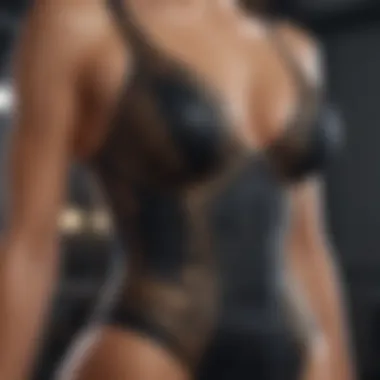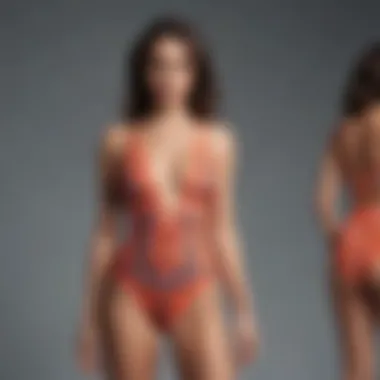Exploring the Allure of Form Fitting One Piece Swimsuits


Intro
Form fitting one piece swimsuits have gained significant attention in recent years. They offer both style and practicality, appealing to women of various ages. With advancements in fabric technology, these swimsuits have evolved from simple designs to fashionable staples. They embrace body positivity, allowing women to feel confident and comfortable.
Understanding the nuances of these swimsuits is crucial. Considerations such as fit, fabric, and style speak to both aesthetics and functionality. In this article, we will explore the key trends associated with swimwear, tips on enhancing your beauty routine while wearing a swimsuit, and touch on sustainable practices in fashion.
Key Trends
Overview of Current Fashion Trends
In current times, swimwear fashions are focusing on sustainability and versatility. Women now prioritize swimsuits that provide ample support without sacrificing style. The one piece style presents itself as a suitable option balancing these factors.
The resurgence of retro-inspired designs is noteworthy. High-cut legs and structured silhouettes dominate the market. Bright colors, bold prints, and cut-outs are common features. This enthusiasm for variety encourages women to express their individual taste.
Popular Beauty Trends
A popular trend that complements swimwear is natural beauty. Women prefer light makeup that enhances their features without overwhelming their natural looks. For example, tinted moisturizers and water-resistant products are favored for poolside or beach trips. The minimalist approach provides a fresh appearance and supports skin health. Additionally, embracing skincare as part of a routine before and after sun exposure is increasingly common among women.
"Fashion is about understanding your body and feeling good in your skin. One piece swimsuits epitomize this concept."
Beauty Tips and Tutorials
Skincare Routines for Different Skin Types
A solid skincare routine is crucial for maintaining healthy skin while enjoying outdoor water activities. The great variety of skin types means customization is needed. Here are some basic tips:
- Oily skin: Use oil-free products and consider gel cleansers.
- Dry skin: Opt for rich moisturizers and avoid harsh scrubs.
- Sensitive skin: Choose soothing products with minimal fragrance.
Applying sunscreen regularly is non-negotiable, ensuring skin remains protected from harmful UV rays.
Step-by-Step Makeup Tutorials
With a preference for a natural look, here’s a basic guide to a light makeup routine:
- Moisturize. Ensure the skin is hydrated.
- Apply tinted sunscreen. This offers coverage and protection.
- Use a brow gel. Define brows with a clear or tinted gel.
- Add a lip tint. Choose a color that complements.
Completing this routine creates a polished yet effortless appearance suitable for various occasions.
Sustainable Practices
Understanding Sustainable Fashion
Sustainable fashion refers to design, production, and consumption focused on minimizing environmental impact. One piece swimsuits manufactured from recycled materials or utilizing eco-friendly fabrics are emerging in the marketplace. This trend aligns with the growing consumer demand for responsible fashion choices.
Tips for Sustainable Beauty
Adopting sustainable beauty practices can coincide with using swimsuits. Consider these tips:
- Look for brands with ethical production standards.
- Choose products that utilize biodegradable or recyclable packaging.
- Reduce waste by selecting multipurpose items that can serve various needs.
Prologue to Form Fitting One Piece Swimsuits
Definition and Characteristics
A form fitting one piece swimsuit is typically a single garment designed to cover the torso and, at times, can extend to various lengths on the leg. They are often made from elastic fabrics that ensure a snug fit. Key characteristics include:
- Sleek Design: The streamlined shape accentuates the body's natural curves without being overly revealing, providing both coverage and style.
- Supportive Features: Many designs include added support through built-in bras or adjustable straps, catering to different body types.
- Variety in Styles: From high-neck silhouettes to cut-out designs, there are options that appeal to diverse preferences.
Overall, the design prioritizes functionality while maintaining aesthetics, which serves multiple needs, whether for sports or leisure.
Historical Context
The history of one piece swimsuits dates back to the early 20th century. Originally designed for women engaging in beach activities or competitive swimming, these garments played a vital role in the changing attitudes towards women's fashion and physical freedom. In the early days, swimsuits were cumbersome and not very form fitting. Women faced significant societal pressure to wear garments that were not only practical but also modest.
As time progressed, these constraints began to lift. By the 1920s, swimwear started to adopt a more streamlined form, allowing for greater movement and less fabric. The mid-20th century saw the introduction of more fashionable options, influenced by Hollywood and elite swimwear designers.
This historical context illustrates how form fitting one piece swimsuits transformed from functional clothing into stylish fashion statements. Women's liberation movements also played a crucial role, allowing a broader acceptance of swimwear that emphasizes body diversity and individual choice.
Ultimately, these swimsuits showcase how fashion can mirror societal changes, making them significant not only for their aesthetic appeal but also for their cultural implications.
Design Evolution of One Piece Swimsuits
The design evolution of one piece swimsuits reflects significant changes in societal norms, fashion trends, and advancements in fabric technology. In this discussion, it is crucial to understand how these swimsuits transitioned from purely functional apparel to sophisticated fashion items. Various factors shaped this transformation, influencing how women perceive and wear them today.


From Utility to Fashion Statement
Historically, one piece swimsuits served functional purposes. Early designs prioritized modesty and practicality. Made from thick materials, they often limited movement and were less flattering. Over the decades, these suits began to adopt more intricate designs and cuts.
The introduction of elastic materials in the mid-20th century revolutionized swimwear. Swimsuits became more form-fitting, allowing for better body contours while offering the support women sought. This shift allowed designers to experiment with styles, leading to a rise in aesthetic appeal.
In more recent years, fashion houses have recognized the potential of one piece swimsuits as statement pieces. High-profile fashion shows now feature one piece designs that rival traditional dresses. Women are encouraged to wear these swimsuits not just on beaches but also as casual daywear. This evolution underscores swimming attire as not only a functional necessity but also a significant player in women's fashion.
Influential Designers and Trends
The impact of influential designers cannot be overstated in the evolution of one piece swimsuits. Designers like Coco Chanel initiated a movement towards more modern swimwear in the 1920s. Chanel liberated women from cumbersome swimwear, advocating lighter materials and simpler silhouettes.
Later, figures like Norma Kamali in the 1980s and more recently, designers such as Eres and Zimmermann, have elevated the one piece swimsuit into luxury items. Their collections feature unique cuts, vibrant colors, and sophisticated styles. This indicates a growing appreciation for swimwear as part of a woman's overall style repertoire, emphasizing individuality and taste.
Trends continue to shape the market with seasonal collections. In the present day, eco-friendly materials are gaining traction, responding to consumers' growing awareness of sustainability. The trend of inclusivity has also influenced designs, accommodating various body types and sizes. This highlights the importance of embracing diversity in swimwear choices, a trend that is likely to grow.
"The evolution of one piece swimsuits reflects cultural identity and personal expression, showcasing how fashion can influence everyday life."
In summary, the design evolution of one piece swimsuits is significant in understanding contemporary swimwear's appeal and functionality. It has transitioned from a practical item to a fashion-forward choice, influenced by various designers and trends while continuing to embrace body positivity and sustainability.
Fabric Technology and Innovation
Types of Fabrics Used
Several types of fabrics are commonly used in the production of one piece swimsuits. These include:
- Nylon: A popular choice for swimwear, nylon offers excellent strength and resistance to wear. It dries quickly and helps with maintaining the shape of the swimsuit.
- Polyester: This fabric is known for its durability and ability to resist fading from sunlight. Polyester swimsuits retain their color longer than many other materials, making them ideal for regular use.
- Lycra/Spandex: Renowned for their flexibility, these stretchy materials provide a snug fit essential for form fitting swimsuits. They allow for unrestricted movement while ensuring the fabric hugs the body.
Each of these fabrics has its benefits, enhancing the suit's functionality and comfort. The choice of material often affects the overall feel, performance in water, and longevity of the swimsuit.
The Role of Stretch and Recovery
Stretch and recovery are fundamental properties in swimsuit fabrics that directly influence how well a suit fits and performs. When we talk about stretch, we refer to the fabric's ability to expand and accommodate different body shapes. Recovery is how well the fabric retains its original shape after being stretched.
- Key Benefits:
- A swimsuit that stretches well can accommodate various body movements, ideal for swimming or other activities.
- Good recovery minimizes sagging and ensures the swimsuit maintains its sleek profile after wearing.
Investing in swimsuits that emphasize these attributes usually means enhanced comfort during wear and better durability over time. The result is a garment that feels tailored to the individual.
Sustainability in Swimwear Fabrics
Sustainability has become a pressing concern in many industries, and swimwear is no exception. The focus on eco-friendly fabrics is rising as consumers become more aware of their choices. Important considerations in sustainable swimwear fabrics include:
- Recycled Materials: Many brands now utilize recycled plastic bottles or other materials to create fabrics. This reduces waste and minimizes the carbon footprint associated with producing new fabric.
- Eco-Friendly Production Processes: The methods used to dye and treat textiles can significantly impact the environment. Brands that focus on sustainable practices in these areas contribute to a healthier planet.
- Biodegradable Fabrics: Emerging innovations aim at creating fabrics that break down over time, reducing long-term waste.
"Choosing sustainable swimwear not only benefits your own comfort but also supports the planet, encouraging a shift towards responsible fashion."
Awareness of these options informs consumers about not just the aesthetic value of their garments but also the ethical implications of their purchasing decisions.
Overall, understanding fabric technology and innovation in one piece swimsuits assists in making informed choices. Those choices impact both the wearer's experience and the broader discussions on sustainability within the fashion industry. This knowledge empowers consumers to select swimsuits that provide both function and appeal.
Style Variations of One Piece Swimsuits
The exploration of style variations within one piece swimsuits is crucial to understanding their broad appeal. Design aspects such as neckline types, cuts, prints, and colors play significant roles in how these swimsuits resonate with individuals. Women of all ages can find a specific style that reflects their personality and body shape, which enhances their confidence and enjoyment in wearing swimwear. Each unique style variation serves both aesthetic and functional purposes, catering to different tastes and body types.
Different Necklines and Cuts
The neckline of a swimsuit can dramatically change its overall look. The options range from classic scoop necks to more daring plunging necklines. A high-neck swimsuit offers a modest approach while providing ample coverage. Conversely, a square neckline enhances a structured feel and can create a visually appealing silhouette. These design choices are not merely about style; they also serve practical functions. For example, a higher neckline can provide more sun protection, while a deeper cut may enhance freedom of movement.
The cut of the swimsuit, whether it be a tank style or a racerback, can also impact functionality. A racerback design promotes comfort, especially for active wearers. Additionally, cuts like side cutouts can add a fashionable flair while maintaining comfort. It's important to consider how these styles complement one's own body type and preferences.
Prints and Patterns
Prints and patterns infuse personality into a one piece swimsuit. From floral designs to geometric shapes, the choices are vast. A bold pattern can serve as a focal point and can effectively draw attention, contributing to one's style statement. On the other hand, minimalist designs may appeal to those seeking a timeless look.
Moreover, the placement of prints can also influence perception. For instance, vertical stripes tend to elongate the body, while horizontal patterns may add width. Understanding how prints and patterns work can help women choose a swimsuit that enhances their confidence and flatters their figure.
Color Psychology in Swimwear Choices
Color selection in swimwear can significantly affect how a person feels and is perceived. Each color evokes different emotions and reactions. For example, blue often transmits calmness, while red can symbolize energy or boldness. When selecting a swimsuit, it's useful to consider color psychology and how it aligns with personal feelings or the environment.
Bright colors can make a lively statement, suitable for vibrant beach outings or pool parties. On the other hand, deeper tones like navy or black can offer a more elegant look, often preferred in resort settings.


Choosing the right color and understanding its psychological impact adds yet another layer to the appeal and functionality of one piece swimsuits.
"Style variations in one piece swimsuits provide women a range of choices to express individuality while ensuring practicality and comfort."
Body Positivity and One Piece Swimsuits
The concept of body positivity has gained significant traction in recent years. It emphasizes the acceptance of all body types, regardless of size, shape, or appearance. One piece swimsuits play a crucial role in this movement. They offer a versatile and flattering option for women of various sizes. Their design not only provides comfort and support but also promotes a sense of confidence. Women wearing these swimsuits often express feelings of empowerment and self-acceptance.
Inclusive Sizing and Fashion
Inclusive sizing is essential in the fashion industry, particularly in swimwear. One piece swimsuits are now available in a wider range of sizes than ever before. This allows women to find a swimsuit that fits their unique body shape. Brands like Aerie and SwimSpot have made strides in offering larger sizes and more diverse fits.
Benefits of inclusive sizing include:
- Greater accessibility: More women can participate in swim and beach activities.
- Enhanced confidence: Women can enjoy the sun without worrying about fit issues.
- Varied styles: Brands are increasingly creating fashionable designs for all sizes.
However, there is still work to be done in ensuring that all bodies are represented. Fashion should not be exclusive or make someone feel unwelcome. By showcasing real bodies, brands can help combat unrealistic beauty standards.
Representation in Media
Media representation is another important aspect of body positivity in swimwear. Historically, advertising and marketing often featured only specific body types, which can alienate a large audience. Recently, there has been a shift. More brands are using models of different sizes, ethnicities, and backgrounds.
This change is significant. A representation that reflects reality can boost self-esteem among viewers. Seeing someone similar in size or shape can help women feel validated.
"Representation in media not only reflects diversity but also inspires women to accept themselves."
Examples of brands promoting this change include Dove and Nike, which have made efforts to include varied body types in their campaigns. These actions help to build a community of acceptance and support, proving that fashion is for everyone.
Practical Considerations for Wearers
Understanding the practical aspects of form fitting one piece swimsuits is essential in making informed decisions. Several key elements influence the wearer's experience, from choosing the right size to ensuring proper maintenance. These factors contribute significantly to comfort, functionality, and overall satisfaction with the garment.
Choosing the Right Size and Fit
Selecting the appropriate size and fit for a one piece swimsuit is crucial for comfort and performance. A swimsuit that fits well enhances mobility and confidence. Here are some tips for achieving a good fit:
- Measure the Body: Always take accurate measurements of the bust, waist, and hips. This step aids in selecting a size that corresponds with the manufacturer's size chart.
- Consider Body Shape: Different body shapes may require varying styles. For instance, an hourglass figure may look flattering in a belted design, while pear-shaped bodies might benefit from swimsuits with wider straps.
- Try It On: When possible, trying on swimsuits can provide invaluable insights. Walk around, stretch, and check for any discomfort or areas of tightness.
- Understand Fabric Stretch: Stretchy materials like spandex and nylon enhance fit. However, understanding how much the material relaxes after usage will help in choosing the right size.
Care and Maintenance
The longevity of a one piece swimsuit is closely tied to proper care and maintenance. Here are some best practices:
- Rinse After Use: Always rinse the swimsuit with cool water after swimming. This action removes chlorine, salt, and sunscreen residues, preventing fabric degradation.
- Avoid Harsh Chemicals: Use mild detergents when machine washing and avoid bleach or fabric softeners that can damage elastic fibers.
- Dry Properly: Air drying is preferable. Hanging in direct sunlight can fade colors. Instead, lay the swimsuit flat or hang to dry in a shaded area.
By following these guidelines, wearers will ensure that their one piece swimsuits remain functional and visually appealing for a longer time.
Proper care extends the life of swimwear significantly, making it a worthwhile investment.
Occasions for One Piece Swimsuits
One piece swimsuits serve multiple purposes based on the occasion. Whether lounging at the beach or visiting a pool, these swimsuits are not merely functional but also stylish. Their versatility makes them appealing for various situations. Women often choose them for comfort, modesty, and a flattering fit. Potential wearers should consider where they plan to wear their swimsuit and what activities they intend to participate in.
Beach vs. Pool
The beach and the pool are two distinct environments where one piece swimsuits shine. At the beach, swimsuits may need to withstand elements like sand and saltwater. A durable fabric that offers a snug fit is crucial for active wearers. Styles that feature higher necklines or thick straps often provide more support in waves, keeping comfort a priority.
In contrast, the pool tends to offer a controlled environment. Here, one piece swimsuits can emphasize style. Bright colors, unique patterns, and innovative designs become focal points. Many women choose swimsuits for aesthetic appeal when lounging poolside or swimming laps.
- Beach Considerations:
- Pool Considerations:
- Fabrics resistant to saltwater and sand
- Styles with support for active swimming
- Color choices that may reflect sunlight or blend in with the surroundings
- Designs that focus on comfort and look good
- Versatile patterns suitable for both swimming and sunbathing
- Materials that dry quickly for ease of transition from water to lounge chairs
"Choosing the right swimsuit for beach versus pool can make a notable difference in experience."
Resort Wear and Beyond
One piece swimsuits play a significant role in resort wear. They can effortlessly transition from water activities to casual dining. When accessorized properly, a one piece can become an elegant outfit. Pairing with cover-ups, shorts, or skirts can create a stylish look for almost any setting.
Many resorts offer facilities that merge relaxation and social interaction. In such instances, the swimsuit becomes a statement piece. Opting for sophisticated styles and patterns can enhance personal style in a resort environment.
- Resort Considerations:


- Selection of colors that align with the resort's ambiance
- Patterns that reflect tropical themes or surroundings
- Use of breathable materials for comfort during warm weather
Overall, the appeal of one piece swimsuits extends across various occasions. From casual beach outings to sophisticated resort wear, they adapt seamlessly to different settings. Understanding the specific needs for each occasion helps women make informed choices.
Cultural Perspectives on Swimwear
Understanding cultural perspectives on swimwear is crucial for recognizing how fashion intertwines with societal norms. The conversation about swimsuits, particularly form fitting one piece swimsuits, encapsulates wider themes of identity, freedom, and societal pressures. Swimsuits are not merely items of clothing; they reflect values and beliefs about body image, femininity, and public perception.
Many cultures have unique traditions and customs associated with swimwear. In some regions, modesty is paramount. This can influence the design and selection of swimwear. For instance, in settings where cultural norms prioritize coverage, one piece swimsuits may be preferred over bikinis. This divergence highlights how swimwear choices resonate deeply with individual identity and cultural expectations.
Conversely, in societies where body positivity and self-expression are celebrated, form fitting one piece swimsuits can symbolize empowerment. They allow wearers to embrace their bodies without the constraints of traditional swimwear. The ability of one piece swimsuits to transcend their basic function, merging practicality with self-assurance, speaks to their broad appeal.
Global Variations and Trends
Swimwear is not a monolithic category but a canvas painted by global variations. Different countries and cultures showcase distinct trends in swimsuits that reflect local tastes and social mores. For example, Italy is renowned for its elegance and stylish cuts. Here, one piece swimsuits frequently incorporate chic designs that appeal to fashion-forward consumers. In contrast, Australia’s beach culture emphasizes vibrant colors and playful patterns. These variations showcase how individuals choose swimsuits that align with their surroundings and lifestyles.
- Regional Highlights:
- Italy: Focus on chic design and sophisticated styles.
- Australia: Emphasis on vibrant colors and playful aesthetics.
Such variations contribute to the global fashion landscape, encouraging women to explore diverse swimswear choices that align with their personalities.
Changing Attitudes Towards Swimwear
Attitudes toward swimwear, especially form fitting options, are shifting significantly. In the past, swimwear faced scrutiny regarding body types and presentation. However, the current mindset promotes acceptance of various body shapes and sizes. The emphasis has transitioned from merely fitting a societal mold to celebrating uniqueness.
Women of all sizes can now participate in the discourse around swimwear, feeling encouraged to choose options that express their style. This change encourages a more inclusive and diverse representation in the swimwear industry. Brands are increasingly offering a wider variety of sizes, ensuring that everyone can find suitable and flattering options.
"The evolving perspectives on swimwear reflect a broader societal shift towards inclusivity and empowerment, allowing women to define their own standards of beauty and confidence."
As these attitudes improve, engagements around swimsuits evolve beyond aesthetics. They include discussions about comfort, functionality, and personal expression. This paradigm shift is critical in understanding how form fitting one piece swimsuits serve a dual purpose in fashion: to be practical while promoting a positive body image.
Understanding and recognizing these cultural perspectives enriches the conversation around swimwear, making it a multidimensional experience for women around the globe.
Comparative Analysis with Other Swimwear Types
In the realm of swimwear, the selection varies greatly. Understanding these differences is key for consumers. This section offers a necessary perspective on form fitting one piece swimsuits in comparison to other options. The analysis provides insights into various elements like functionality, style preferences, and personal comfort. When making decisions about swimwear, these aspects often play critical roles in a woman's choice.
Bikinis vs. One Piece Swimsuits
When contrasting bikinis with one piece swimsuits, various factors come into play. Bikinis are often perceived as more daring, offering a minimalist style. They embrace body confidence and sun exposure. However, they may not be suitable for every situation.
On the other hand, one piece swimsuits provide an alternative that offers ample coverage. They are versatile and appropriate for various activities. Wearing one piece swimsuits can grant women a sense of reassurance. This effect is particularly notable during rigorous activities, like swimming or beach sports.
Key points of comparison include:
- Coverage and Support: One pieces typically provide more coverage, which can help women feel more secure during water activities.
- Modesty: Some women prefer the modesty that a one piece provides compared to the revealing nature of bikinis.
- Stability: In one piece swimsuits, the design often allows for better stability, reducing the chance of wardrobe malfunctions.
- Trends: While bikinis may often lead fashion trends, one piece swimsuits can be both chic and stylish, regardless of trends.
Trends in Other Swimwear Options
The swimwear market is continually evolving, allowing for fresh trends. Besides bikinis and one piece swimsuits, other variations exist. Some significant options are tankinis, swim dresses, and rash guards. Each provides specific benefits based on user preferences and needs.
- Tankinis: These offer a dual-layer design, combining top and bottom coverage without compromising style. They are suitable for women looking for a balanced coverage option.
- Swim Dresses: While traditionally more modest, they serve the needs of women interested in a fashionable yet functional approach to swimwear.
- Rash Guards: Though primarily aimed at sun protection, they have gained popularity for their athletic look and practical use in various water sports.
Incorporating these diverse options allows women to select swimwear based on personal style and comfort. Ultimately, understanding how one piece swimsuits stack up against other options provides a clearer view of what suits individual needs.
Future Trends in One Piece Swimwear
The world of swimwear is constantly evolving. Form fitting one piece swimsuits, in particular, represent a blend of functionality, fashion, and comfort. As trends shift, it is crucial to understand the future trends in one piece swimwear to stay informed about the industry and the type of styles that will dominate in the coming years. This knowledge is especially relevant for women aiming to make informed choices when selecting swimwear that fits their personal style and practical needs.
Emerging Technologies in Production
Advancements in technology are increasingly reshaping the swimwear industry. Smart textiles and innovative materials are now being used in the production of one piece swimsuits. These fabrics are designed to enhance comfort, durability, and performance.
- Quick-dry materials: These are engineered to reduce water retention, allowing for a more comfortable experience after swimming.
- UV protection: Many new materials also offer resistance to harmful sun rays, promoting skin health without the need for excessive sunscreen.
- Eco-friendly options: Sustainable practices are becoming more common, with brands producing swimwear from recycled materials like plastic bottles.
The integration of these technologies not only improves the swimsuit’s functionality but also addresses environmental concerns, making them more appealing to conscious consumers.
Predicted Fashion Trends
Fashion trends are often cyclical, but the emergence of new styles can redefine what is considered fashionable. In the context of one piece swimsuits, several trends are anticipated to gain traction:
- Bold colors and patterns: Expect a resurgence of vibrant colors and striking prints as a way to express individuality.
- High neckline and racerback designs: These styles offer both support and modern aesthetics, appealing to active women.
- Cutouts: Strategically placed cutouts can add allure while maintaining modest coverage, reflecting a balance between fashion and function.
The future of swimwear is not just about looking good; it's about feeling confident and empowered.
Additionally, there is a growing emphasis on versatile swimwear that easily transitions from the beach to more casual settings. Integrating swimwear into everyday outfits will continue to rise, making form fitting one piece swimsuits a fundamental aspect of a woman's wardrobe.
Awareness of these upcoming trends aids consumers in making choices that resonate with their personal style while keeping a pulse on the larger fashion landscape.



